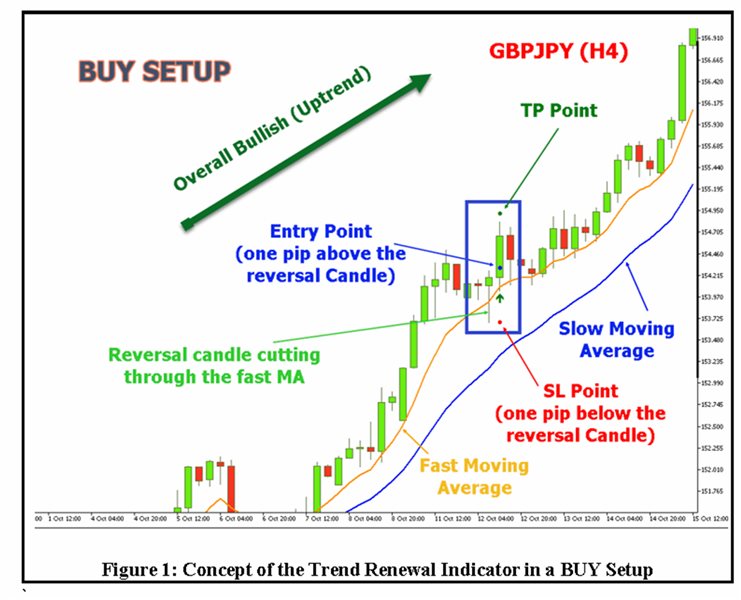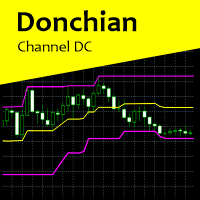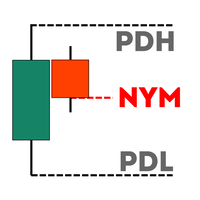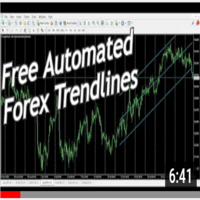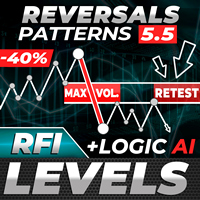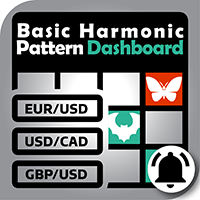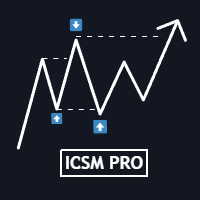Trend Renewal Indicator
- Indicadores
- Mostafa Au Ismail
- Versión: 1.0
- Activaciones: 5
1. GENERAL DESCRIPTION OF THE TREND RENEWAL INDICATOR
The Trend Renewal Indicator (TRI) is a simple yet very powerful trend-following indicator that works on the MT5 trading platform of MetaQoutes (MLQ5).
The TRI indicator suits small and large accounts, and is ideal for very large accounts. It has been used for decades by fund managers and institutional traders, but never offered to retail traders.
The TRI works with any instrument, including currencies, crypto currencies, metals, hard and soft commodities as well as indices.
The Trend Renewal Indicator combines two trending moving averages and a strong reversal candle to generate a trade signal that marks the continuation of the original trend after a brief retracement. An example for a BUY setup is shown in Figure 1, and a similar example for a SELL setup is shown in Figure 2. Executing a trade after a triggered signal requires further consideration as discussed later; the purpose is to apply the necessary discretion that accounts for possible news announcement and zones of support and resistance.
The TRI can be attached to H1, H4 and D1 charts, but it is ideal for the longer timeframes H4 and D1. In particular, a trading signal on the D1 chart is extremely powerful, and it can produce high profitability rates.
The TRI does no trade too often, but when the signal appears it will have very high probability of success. Ideally, the trader can attach the TRI to all the charts you wish to trade and wait for the signal. The trader can also activate the email alert and push notification to receive the signals as they appear.
2. CONDITIONS FOR THE ENTRY SIGNAL
2.1 Buy Setup
An entry signal appears in the form of an upward arrow when 2 conditions are fulfilled: (1) the fast moving average is above the slow moving average, (2) a reversal candle is formed after a brief pullback of the price towards the 2 moving averages (see Figure 1). To qualify, the reversal candle must penetrate the fast moving average and its head (body) should be small compared with the total length of the candle in terms of a ratio to be specified by the user.
The triggered signal will draw 3 dots on the new candle that will form after the reversal candle (see Figure 3). The first dot will represent the entry price for a limit order (BUY stop) at a price above the top of the reversal candle. The second dot will represent the stop loss (SL) price, which will be located just below the reversal candle. The third dot will determine the take profit (TP) price level based on the reward to risk ratio specified by the user. The user MUST analyse the signal before execution as detailed later.
2.2 Sell Setup
An entry signal appears in the form of a downward arrow when 2 conditions are fulfilled: (1) the fast moving average is below the slow moving average, (2) when a reversal candle is formed after a brief pullback of the price towards the 2 moving averages (see Figure 2). To qualify, the reversal candle must penetrate the fast moving average and its “inverted” head (body) should be small compared with the total length of the candle in terms of a ratio to be specified by the user.
The triggered signal will draw 3 dots on the new candle that will form after the reversal candle. The first dot will represent the entry price for a limit order (SELL stop) at a price below the bottom of the reversal candle. The second dot will represent the stop loss (SL) price, which will be located just above the reversal candle. The third dot will determine the take profit (TP) price level based on the reward to risk ratio specified by the user. The user must analyse the signal before execution as detailed later.
SETTINGS
Points for Entry: Number of points (pips/10) above the previous candle to enter BUY or below the previous candle to enter SELL
SL (points): Number of points (pips/10) below the previous candle to Stop Loss in a BUY or above the previous candle to Stop Loss in a SELL
Fast MA: Period, Type, Type of Price
Slow MA: Period, Type, Type of Price
3. HOW TO USE THE TRI INDICATOR TO EXECUTE TRADES
The trader should be aware of four main factors before executing the signal to increase the probability of success:
1. The trader must confirm that the price is indeed trending prior to the current setup. This is covered in Section 3.1.
2. The trader must ensure that signals triggered on a small time frame such as H1 must align with higher time frames such as H4 and D1. More on that in Section 3.3.
3. The trader must examine the support and resistance levels near the current price. This is explained in Section 3.4.
4. The trader must check any pending news associated with the intended instrument. In this regard, depending on the type of impact the news has, the trader may choose to avoid trading a few hours prior to or after the news announcement. In the case of unscheduled news, the trader will need to manage the trade objectively.
3.1 Confirmation of an established trend before the signal
As indicated earlier, an entry signal MUST NOT be executed until further analysis is made, including confirmation that a trend had already been established prior to the current price structure without much stagnation (i.e., avoid long sideway periods). Since price moves in waves, it is recommended that 2 waves at least must have been formed before entering on the third wave. BUY and SELL examples are presented in Figure 4 and Figure 5, respectively.
3.2 Avoidance of stagnated periods
Price consolidation over a long period may denote overall trend reversal. For this reason, it is advisable to avoid entry when the price lurks for long within a price zone. In other words, the trader must see a reasonable angle between the slow and fast moving averages before executing the signal. An example of failed signals due to stagnation is shown in Figure 6.
3.3 Alignment of small Timeframe with Higher Timeframe
As discussed earlier, the TRI can trade H1, H4 and D1 time frames. It is strongly advised that in trading H1, the overall trend of the H1 chart must align with the trend of both H4 and D1. Moving averages can be used to ascertain this requirement, such that the fast MA is above the slow MA for H1, H4 and D1 for BUY entry and the fast MA is below the slow MAs for H1, H4 and D1 for SELL entry.
This also applies to trading H4 charts where the trend must align with the D1 trend.
3.4 Consideration of support and resistance
The two zones of price within the 3 dots that denote the entry, SL and TP are generally sensitive to nearby support and resistance levels (the two zones are marked in Figure 8). This effect can be summarized as follows:
BUY Signals
• The presence of a strong support zone within the SL zone may be positive for the trade when the price moves downward (see Figure 7).
• The presence of a strong resistance zone within the TP zone may be negative for the trade, since it may cause rejection of the uptrend movement (Figure 8).
SELL Signals
• The presence of a strong resistance zone within the SL zone may be positive for the trade when the price moves upward.
• The presence of a strong support zone within the TP zone may be negative for the trade, since it may cause rejection of the downtrend movement.
Note that entering or rejecting a trade may depend on the exact location of the support and resistance zones with respect to the trade SL and TP by managing the trade (partial closure etc.).
4. PARAMETERS OF THE TRI INDICATOR
A screenshot of the various parameters used with the indicator is shown in Figure 9. Note that only a small number of parameters is needed.
• Points of Entry (in points): How far the entry price is from the top of the reversal candle for BUY or from the bottom of the reversal candle for SELL
• SL points: How far the entry price is from the bottom of the reversal candle for BUY, or from the top of the reversal candle for SELL
• Reward to Risk Ratio: The ratio of the TP to SL from the entry price
• Fast MA Period: Period used for the fast exponential moving average
• Slow MA Period: Period used for the slow exponential moving average
• Reversal Candle Head Ratio: Relative size of the head of the reversal candle to the total length of the candle
• Email Alert: Option to receive notification via email
• Push Notification: Option to receive notification via mobiles
The optimum set of parameters is provided with purchase of the indicator.
5. IMPORTANT TIPS
• As shown in Figure 10, formation of a wick before hitting the entry price increases the probability of success of the trade: the longer the wick, the better the results. Note how the bearish candle formed a top wick before reversing to hit the entry point towards a full TP in this example.
• A long wick of the reversal candle add strength to the signal. See the comparison in Figure 11. The minimum length of the reversal candle can be used as an additional criterion to enter a trade using the standard average true indicator (ATR).
• Generally, risk and money management must be applied during trading. It is recommended to limit the maximum risk to 3% per trade when using the TRI.
• Securing partial profits is highly recommended as part of trade management. Implementing a Breakeven SL may also be needed when the price moves in the favorable direction.
• Opening a new trade close to rollover time is not recommended due to erratic movement of prices around this time.
• Managing an open trade around rollover time may be critical, since erratic movement of the price may hit the SL. Temporary shift of the SL during rollover can provide a solution to this issue.
• Trading highly volatile pairs such as gold and digital currencies is not recommended using the smaller timeframe of H1 due to the characteristic big moves of these pairs. Back and forward testing has shown that the D1 timeframe produces excellent results in comparison.

